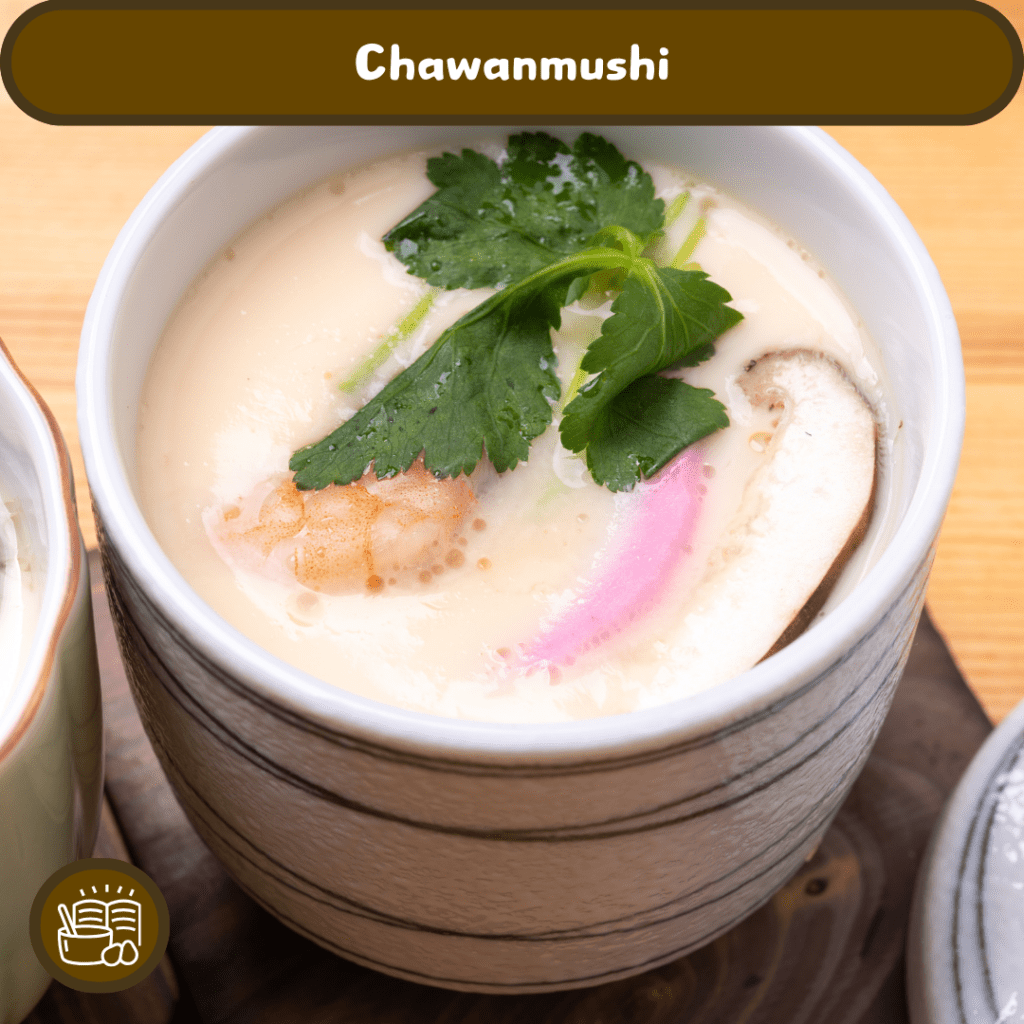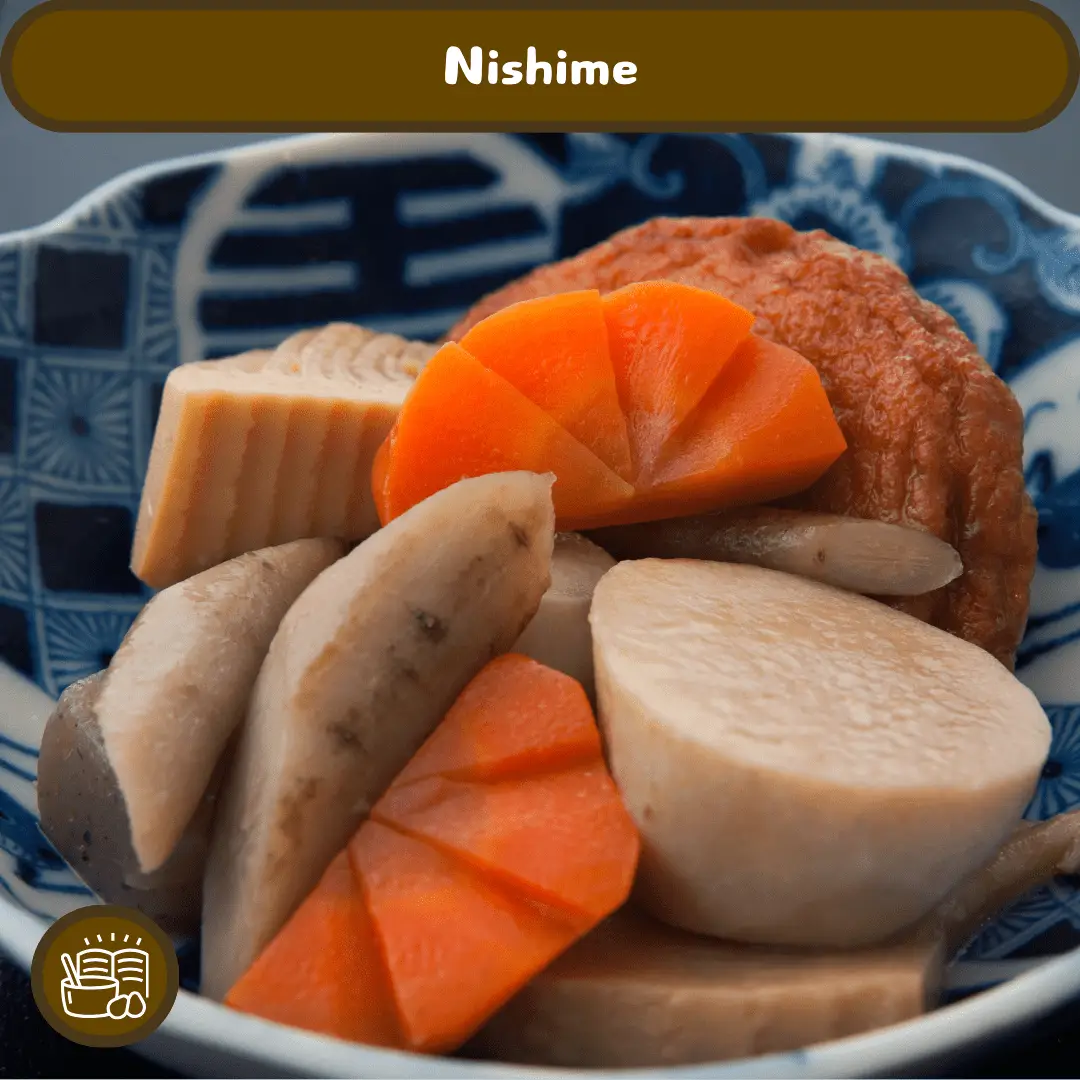
How to make: Chawanmushi, which is a savory delicate egg custard with various healthy ingredients inside! It can be eaten hot or cold, but I prefer it hot and fresh. It makes for a tasty side dish to any Japanese meal!
Ingredients (serves 3-4 people)
| Japanese | English |
|---|---|
| 卵 … 2個 | Eggs … 2 |
| 椎茸 … 1〜2枚 | Shiitake mushrooms … 1-2 pieces |
| 鶏もも肉 … 50g | Chicken thigh meat … 50g |
| かまぼこ … 4~5切れほど | Kamaboko (fish cake) … about 4-5 slices |
| 三つ葉 … 1/4束 | Mitsuba (Japanese wild parsley) … 1/4 bunch |
| だし汁(※) … 300ml | Dashi broth (*) … 300ml |
| 醤油(あれば薄口) … 小さじ2 | Soy sauce (preferably light) … 2 teaspoons |
| 塩 … 小さじ1/5 | Salt … 1/5 teaspoon |
Note: You can actually make delicious chawanmushi without dashi broth (in that case, please use 300ml of water).
Steps
Making Chawanmushi (Steamed Egg Custard) and Preparation
*The basic ratio for chawanmushi is “2 eggs, 300ml of dashi broth, 2 teaspoons of soy sauce, and 1/5 teaspoon of salt”
*The simplest combination of ingredients for chawanmushi is “chicken thigh meat, shiitake mushrooms, kamaboko, and mitsuba,” so we will use these ingredients this time.
- Cut off the stems of the shiitake mushrooms and cut them into 4-6 pieces, cut the kamaboko into gingko leaf shapes for easy eating, and cut the mitsuba into 1-2cm widths.
- For the chicken, you can purchase pieces already cut into 1cm cubes for rice dishes, or if they are larger, cut them into 1-1.5cm cubes.
- Since chawanmushi has a delicate flavor, it is recommended to put the chicken in a container, pour boiling water over it to remove excess fat and any chicken odor. Sprinkle a pinch of salt (not included in the amount) over the chicken after draining the water to marinate it.
- Note: Based on the basic ingredients, you can replace kamaboko with boiled shrimp, shiitake mushrooms with shimeji mushrooms, or add boiled ginkgo nuts or lily bulbs. There are various recipes for chawanmushi with lots of ingredients!
- Prepare two bowls for making the egg mixture (you only need one bowl if you’re not straining the egg mixture, but I’ll first introduce the process of straining). In one bowl, mix and dissolve the ingredients for A (300ml of dashi broth and seasonings: 2 teaspoons of soy sauce, and 1/5 teaspoon of salt).
- One thing to be careful of is that the dashi broth should not be too hot. Since you will be combining it with eggs immediately afterward, be sure to cool it to just below body temperature.
- Note: Light soy sauce is recommended for its beautiful color. If you have light soy sauce, that is preferred. Dark soy sauce is also okay, but if it is the type that produces a dark color, reduce the amount slightly to 1 and 1/2 teaspoons of soy sauce, and add a pinch of salt to compensate for the reduced saltiness, adjusting to taste.
- In the other bowl, crack the eggs and beat them well to ensure there are no clumps of egg white. Then, pour the mixture from A into the bowl with the beaten eggs.
- Although the chawanmushi egg mixture is complete once you have mixed the beaten eggs with A, it will have a smoother texture if you strain the egg mixture once.
- Note: Personally, when I’m in a hurry or want to minimize dishwashing in my daily cooking, I often make the egg mixture without straining. In that case, simply beat the eggs well first, then combine them with the dashi broth and seasonings. Some undissolved egg white or chalaza may remain, and the surface of the finished dish may be slightly rougher, but skipping the straining step is also okay.
- While making the egg mixture, boil water in the steamer, and evenly distribute the prepared ingredients and egg mixture into serving dishes.
- Layer the chicken, kamaboko, shiitake mushrooms, and mitsuba in the dishes (you can also add the mitsuba from the beginning). Then, lightly mix the egg mixture bowl from the bottom and gently pour it over the ingredients.
- There are several ways to steam chawanmushi, such as using a steamer, boiling water in a pot and steaming, or using a low-temperature steaming setting on a microwave if available, set to 90-95°C.
- When steaming, to prevent water droplets from falling onto the chawanmushi, it is recommended to place a cloth under the lid or wrap each dish’s opening with aluminum foil (you can skip this if it’s okay for some water droplets to fall).
- Also, the steaming time for chawanmushi is: 1) After setting up the steamer, steam over high heat for about 2-3 minutes with the lid tightly closed. 2) Check to make sure that steam is coming out steadily, then slightly move the lid and insert a chopstick. 3) Steam over low heat for about 25 minutes.
- Note: Steaming over high heat at the beginning is to raise the temperature since the inside of the steamer cools down when the steamer is set or the lid is opened or the heat is lowered. If you can insert a chopstick into the chawanmushi dish while it is on low heat, whether it is steamed for 30 minutes or 40 minutes, the state of the chawanmushi will not change (except for a slight deterioration in the color of the mitsuba), so to serve the chawanmushi hot, steam it with plenty of time in advance.
- Note: If you steam chawanmushi over high heat for a long time, air bubbles may form in the eggs! Additionally, if it doesn’t set even after steaming for the specified time, increase the heat slightly and steam for an additional few minutes to ensure it is fully cooked.
- If the chawanmushi dish is slightly shaken and it feels firm, insert a bamboo skewer into the center. If clear liquid comes out, it is done.
Recipe is from here and translated by me:
https://www.sirogohan.com/recipe/chawanmusi/




